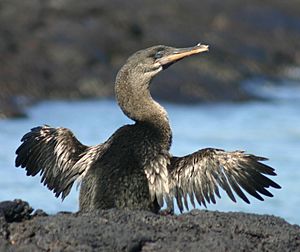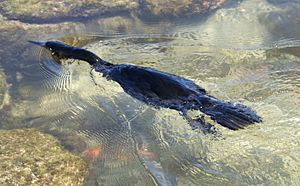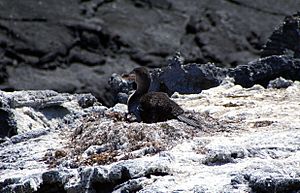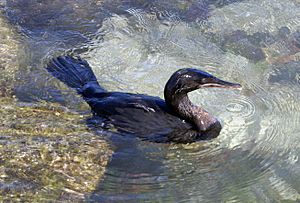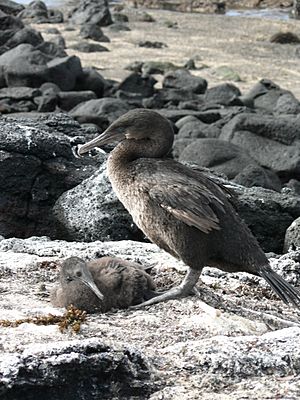Flightless cormorant facts for kids
Quick facts for kids Flightless cormorant |
|
|---|---|
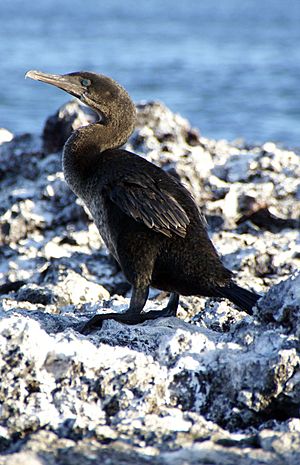 |
|
| Elizabeth Bay, Isabela Island, Galapagos. | |
| Conservation status | |
| Scientific classification | |
| Genus: |
Nannopterum
|
| Species: |
harrisi
|
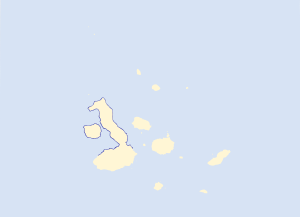 |
|
| Synonyms | |
|
Phalacrocorax harrisi |
|
The flightless cormorant (Nannopterum harrisi), also called the Galapagos cormorant, is a special bird found only in the Galapagos Islands. It is a type of cormorant, which are diving birds. This cormorant is unique because it is the only one known to have lost the ability to fly. It is a great example of the very unusual fauna (animals) living in the Galapagos.
Scientists first put this bird in its own genus (a group of related species) called Nannopterum. Later, it was grouped with most other cormorants in the genus Phalacrocorax. However, a study in 2014 suggested it should go back into Nannopterum with two other American cormorant species. The IOC agreed with this in 2021.
Contents
Meet the Flightless Cormorant
The flightless cormorant is the biggest living member of its bird family. It can be about 89 to 100 centimeters (35 to 39 inches) long. It weighs between 2.5 and 5.0 kilograms (5.5 to 11 pounds). Its wings are very small, only about one-third the size needed for a bird of its size to fly. The keel on its chest bone is also much smaller. This is where birds usually attach the large muscles needed for flight.
Like all cormorants, this bird has webbed feet and strong legs. These help it swim fast through the water. It hunts for fish, small octopuses, and other tiny sea creatures. The cormorant feeds close to the sea floor and stays within 200 meters (650 feet) of the shore.
Flightless cormorants look a bit like ducks, but they have short, stubby wings. Their upper body is blackish, and their underside is brown. They have a long beak that is hooked at the end. Their eyes are a bright turquoise color. All four of their toes are joined by webbed skin, which is common for cormorants. Males and females look similar, but males are larger and about 35% heavier. Young birds look like adults but are glossy black with dark eyes. Adult cormorants make low growling sounds.
Why Their Feathers Are Different
Unlike many birds, the flightless cormorant's feathers are not waterproof. After each dive, they spend time drying their small wings in the sunlight. Their flight feathers are similar to other cormorants. However, their body feathers are much thicker, softer, and more like hair. They produce very little oil from their preen gland. Instead, air trapped in their dense feathers helps them stay afloat and not get too wet.
Where They Live and Their Home
This special cormorant lives only in the Galapagos Islands, Ecuador. It has a very small home area. You can find it on just two islands: Fernandina and the northern and western coasts of Isabela. They live in these areas because of a cold ocean current called the Equatorial Undercurrent. This current brings cold, nutrient-rich water, which means lots of food for the cormorants.
The number of these birds has changed a lot over time. In 1983, a strong El Niño event caused their population to drop by half, to only 400 birds. But they recovered quickly. By 1999, there were about 900 of them.
These birds live on the rocky shores of volcanic islands. They hunt for food in shallow coastal waters, including bays and narrow passages. Flightless cormorants do not move around much. They usually stay in the same area, often just a few hundred meters of coastline, for their whole lives. They also breed in these local spots. Because they stay in one place, there are small genetic differences between the main groups of birds, especially between those on Fernandina and Isabela Island.
Reproduction and Life Cycle
Nesting usually happens between April and October. This is when the sea water is coldest, meaning there is plenty of food for the birds. It also reduces the risk of baby chicks getting too hot. During this time, colonies (groups) of up to about 12 pairs form.
The courtship (mating ritual) starts in the sea. The male and female swim around each other with their necks bent like snakes. Then, they move onto land. The male bird usually brings pieces of seaweed (and sometimes even bits of rope) to the female. She then weaves these into a large nest, just above the high water mark.
The female usually lays three whitish eggs in each clutch (group of eggs). However, often only one chick survives. Both the male and female take turns sitting on the eggs to keep them warm. Once the eggs hatch, both parents continue to protect the chicks from heat, cold, and predators. They also share the job of feeding their young. The female often brings 40-50% more food than the male.
As the chicks get closer to being independent at about 70 days old, if there is a lot of food, the female might leave the chicks. The male will then finish raising them. The female will find a new mate and breed again. This means females can raise several groups of chicks in one season. However, studies show that there isn't enough food for this to happen very often.
About 90% of both male and female cormorants survive each year. They can live for about 13 years. Enough new birds are born and join the population to keep it stable.
Protecting the Flightless Cormorant
These cormorants evolved on islands that had no predators. Because they had no enemies and could find plenty of food by diving along the shore, they didn't need to fly. Over time, they lost the ability to fly. In fact, having wings that trapped air might have even been a problem for birds that dive from the surface.
However, since humans discovered the islands, they are no longer free of predators. Cats, dogs, and pigs have been brought to the islands over the years. Also, these birds are not afraid of humans. You can easily get close to them and even pick them up.
In the past, wild dogs were a big danger to the cormorants on Isabela Island. But these dogs have since been removed from the island. A big future threat would be if rats or cats were introduced to Fernandina Island. Fishing with nets is also a current danger. This not only reduces the fish the cormorants eat, but birds often get caught in the nets and die.
Cold ocean water during certain seasons has shaped how flightless cormorants breed. If the sea water gets several degrees warmer during breeding season, or stays warm for a long time (like during El Niño events), fewer chicks survive. El Niño events seem to be happening more often and are stronger in recent years. This might be linked to climate change. A large oil spill would also be a big threat.
Even though the flightless cormorant population is small and lives in a limited area, it can recover quickly from problems. This is true as long as the population doesn't drop below a certain critical number.
The flightless cormorant is one of the rarest birds in the world. A survey in 2004 by the Charles Darwin Research Station found about 1,500 of these birds. In 2009, BirdLife International estimated there were only 900. However, a more recent count in 2011 found 1,679 birds. It used to be listed as Endangered by the IUCN (a group that tracks endangered species). But new research shows it's not as rare as once thought, and its numbers have become stable. Because of this, its status was changed to Vulnerable in 2011.
All groups of these birds live inside the Galapagos National Park and Marine Reserve. Also, the Galapagos Islands were named a World Heritage Site in 1978. The Charles Darwin Research Station regularly checks on the cormorants to see how their numbers change. Ideas for protecting them include continuing to count them every year. Also, they suggest limiting human visits to their home areas. Finally, they want to prevent fishing with nets where the birds hunt for food.
See also
 In Spanish: Cormorán mancón para niños
In Spanish: Cormorán mancón para niños



